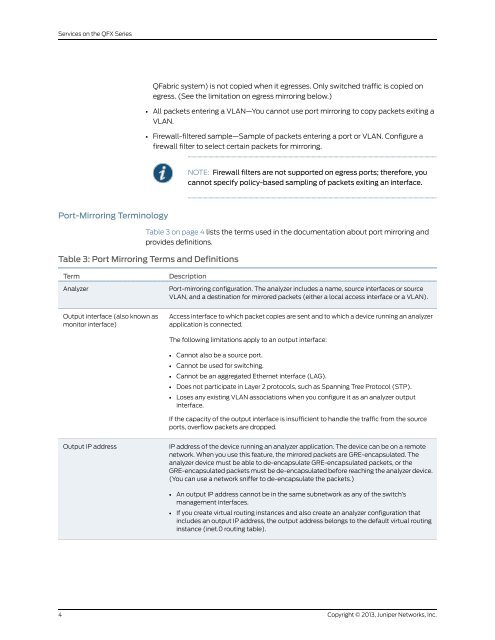Services on the QFX Series - Juniper.net
Services on the QFX Series - Juniper.net
Services on the QFX Series - Juniper.net
Create successful ePaper yourself
Turn your PDF publications into a flip-book with our unique Google optimized e-Paper software.
<str<strong>on</strong>g>Services</str<strong>on</strong>g> <strong>on</strong> <strong>the</strong> <strong>QFX</strong> <strong>Series</strong><br />
QFabric system) is not copied when it egresses. Only switched traffic is copied <strong>on</strong><br />
egress. (See <strong>the</strong> limitati<strong>on</strong> <strong>on</strong> egress mirroring below.)<br />
• All packets entering a VLAN—You cannot use port mirroring to copy packets exiting a<br />
VLAN.<br />
• Firewall-filtered sample—Sample of packets entering a port or VLAN. C<strong>on</strong>figure a<br />
firewall filter to select certain packets for mirroring.<br />
NOTE: Firewall filters are not supported <strong>on</strong> egress ports; <strong>the</strong>refore, you<br />
cannot specify policy-based sampling of packets exiting an interface.<br />
Port-Mirroring Terminology<br />
Table 3 <strong>on</strong> page 4 lists <strong>the</strong> terms used in <strong>the</strong> documentati<strong>on</strong> about port mirroring and<br />
provides definiti<strong>on</strong>s.<br />
Table 3: Port Mirroring Terms and Definiti<strong>on</strong>s<br />
Term<br />
Analyzer<br />
Descripti<strong>on</strong><br />
Port-mirroring c<strong>on</strong>figurati<strong>on</strong>. The analyzer includes a name, source interfaces or source<br />
VLAN, and a destinati<strong>on</strong> for mirrored packets (ei<strong>the</strong>r a local access interface or a VLAN).<br />
Output interface (also known as<br />
m<strong>on</strong>itor interface)<br />
Access interface to which packet copies are sent and to which a device running an analyzer<br />
applicati<strong>on</strong> is c<strong>on</strong>nected.<br />
The following limitati<strong>on</strong>s apply to an output interface:<br />
• Cannot also be a source port.<br />
• Cannot be used for switching.<br />
• Cannot be an aggregated E<strong>the</strong>r<strong>net</strong> interface (LAG).<br />
• Does not participate in Layer 2 protocols, such as Spanning Tree Protocol (STP).<br />
• Loses any existing VLAN associati<strong>on</strong>s when you c<strong>on</strong>figure it as an analyzer output<br />
interface.<br />
If <strong>the</strong> capacity of <strong>the</strong> output interface is insufficient to handle <strong>the</strong> traffic from <strong>the</strong> source<br />
ports, overflow packets are dropped.<br />
Output IP address<br />
IP address of <strong>the</strong> device running an analyzer applicati<strong>on</strong>. The device can be <strong>on</strong> a remote<br />
<strong>net</strong>work. When you use this feature, <strong>the</strong> mirrored packets are GRE-encapsulated. The<br />
analyzer device must be able to de-encapsulate GRE-encapsulated packets, or <strong>the</strong><br />
GRE-encapsulated packets must be de-encapsulated before reaching <strong>the</strong> analyzer device.<br />
(You can use a <strong>net</strong>work sniffer to de-encapsulate <strong>the</strong> packets.)<br />
• An output IP address cannot be in <strong>the</strong> same sub<strong>net</strong>work as any of <strong>the</strong> switch’s<br />
management interfaces.<br />
• If you create virtual routing instances and also create an analyzer c<strong>on</strong>figurati<strong>on</strong> that<br />
includes an output IP address, <strong>the</strong> output address bel<strong>on</strong>gs to <strong>the</strong> default virtual routing<br />
instance (i<strong>net</strong>.0 routing table).<br />
4<br />
Copyright © 2013, <strong>Juniper</strong> Networks, Inc.
















